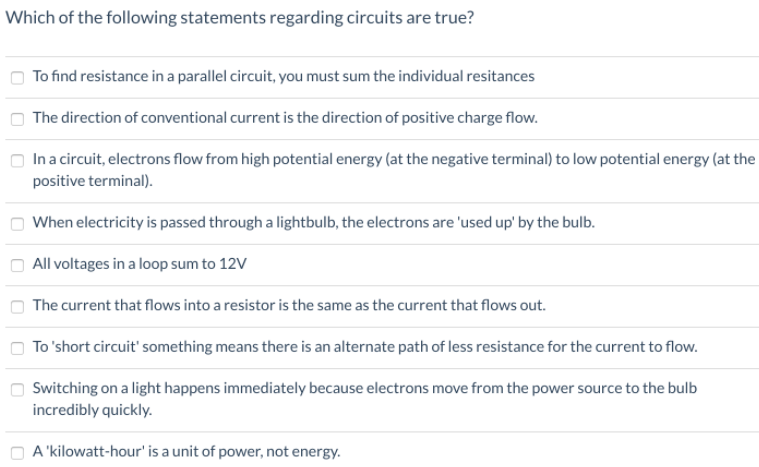Which of the following statements regarding circuits are true? To find resistance in a parallel circuit, you must sum the individual resitances The direction of conventional current is the direction of positive charge flow. In a circuit, electrons flow from high potential energy (at the negative terminal) to low potential energy (at the positive terminal). When electricity is passed through a lightbulb, the electrons are 'used up' by the bulb. All voltages in a loop sum to 12V The current that flows into a resistor is the same as the current that flows out. To 'short circuit' something means there is an alternate path of less resistance for the current to flow. Switching on a light happens immediately because electrons move from the power source to the bulb incredibly quickly. A 'kilowatt-hour' is a unit of power, not energy.
Which of the following statements regarding circuits are true? To find resistance in a parallel circuit, you must sum the individual resitances The direction of conventional current is the direction of positive charge flow. In a circuit, electrons flow from high potential energy (at the negative terminal) to low potential energy (at the positive terminal). When electricity is passed through a lightbulb, the electrons are 'used up' by the bulb. All voltages in a loop sum to 12V The current that flows into a resistor is the same as the current that flows out. To 'short circuit' something means there is an alternate path of less resistance for the current to flow. Switching on a light happens immediately because electrons move from the power source to the bulb incredibly quickly. A 'kilowatt-hour' is a unit of power, not energy.
Delmar's Standard Textbook Of Electricity
7th Edition
ISBN:9781337900348
Author:Stephen L. Herman
Publisher:Stephen L. Herman
Chapter17: Resistive-inductive Series Circuits
Section: Chapter Questions
Problem 1PA: An AC electric motor is connected to a 240-V, 60-Hz source. A clamp-on ammeter with a peak hold...
Related questions
Question

Transcribed Image Text:Which of the following statements regarding circuits are true?
To find resistance in a parallel circuit, you must sum the individual resitances
The direction of conventional current is the direction of positive charge flow.
In a circuit, electrons flow from high potential energy (at the negative terminal) to low potential energy (at the
positive terminal).
When electricity is passed through a lightbulb, the electrons are 'used up' by the bulb.
All voltages in a loop sum to 12V
The current that flows into a resistor is the same as the current that flows out.
To 'short circuit' something means there is an alternate path of less resistance for the current to flow.
Switching on a light happens immediately because electrons move from the power source to the bulb
incredibly quickly.
A 'kilowatt-hour' is a unit of power, not energy.
Expert Solution
This question has been solved!
Explore an expertly crafted, step-by-step solution for a thorough understanding of key concepts.
This is a popular solution!
Trending now
This is a popular solution!
Step by step
Solved in 2 steps

Recommended textbooks for you

Delmar's Standard Textbook Of Electricity
Electrical Engineering
ISBN:
9781337900348
Author:
Stephen L. Herman
Publisher:
Cengage Learning

Delmar's Standard Textbook Of Electricity
Electrical Engineering
ISBN:
9781337900348
Author:
Stephen L. Herman
Publisher:
Cengage Learning